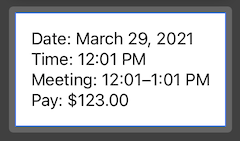Text 中的插值
Text 是 SwiftUI 中最简单和最常见的 View 了,最基本的用法,我们可以直接把一个字符串字面量传入,来创建一个 Text:
1
Text("Hello World")

在 iOS 14 (SwiftUI 2.0) 中,Apple 对 Text 插值进行了很多强化。除了简单的文本之外,我们还可以向 Text 中直接插入 Image:
1
Text("Hello \(Image(systemName: "globe"))")

这是一个非常强大的特性,极大简化了图文混排的代码。除了普通的字符串和 Image 以外,Text 中的字符串插值还可以接受其他一些“奇奇怪怪”的类型,部分类型甚至还接受传入特性的 formatter,这给我们带来不少便利:
1
2
3
4
5
6
7
8
9
10
Text("Date: \(Date(), style: .date)")
Text("Time: \(Date(), style: .time)")
Text("Meeting: \(DateInterval(start: Date(), end: Date(timeIntervalSinceNow: 3600)))")
let fomatter: NumberFormatter = {
let f = NumberFormatter()
f.numberStyle = .currency
return f
}()
Text("Pay: \(123 as NSNumber, formatter: fomatter)")

但是同时,一些平时可能很常见的字符串插值用法,在 Text 中并不支持,最典型的,我们可能遇到下面两种关于 appendInterpolation 的错误:
1
2
3
4
5
6
7
8
9
10
11
Text("3 == 3 is \(true)")
// 编译错误:
// No exact matches in call to instance method 'appendInterpolation'
struct Person {
let name: String
let place: String
}
Text("Hi, \(Person(name: "Geralt", place: "Rivia"))")
// 编译错误:
// Instance method 'appendInterpolation' requires that 'Person' conform to '_FormatSpecifiable'
一开始遇到这些错误很可能会有点懵,appendInterpolation 是什么,_FormatSpecifiable 又是什么?要怎么才能让这些类型和 Text 一同工作?
我打算花两篇文章对这个话题和相关的 API 设计进行一些探索。
在本文中,我们会先来看看到底为什么 Text 可以接受 Image 或者 Date 作为插值,而不能接受 Bool 或 Person 这样的类型,这涉及到 Swift 5 中引入的自定义字符串插值的特性。在稍后的下篇里,我们会探索这个话题背后引出的更深层次的内容,来看看 SwiftUI 中的本地化到底是如何工作的。我们也会讨论应该如何解决对应的问题,并利用这些的特性写出更正确和漂亮的 SwiftUI 代码。
幕后英雄:LocalizedStringKey
SwiftUI 把多语言本地化的支持放到了首位,在直接使用字符串字面量去初始化一个 Text 的时候,所调用到的方法其实是 init(_:tableName:bundle:comment:):
1
2
3
4
5
6
7
8
extension Text {
init(
_ key: LocalizedStringKey,
tableName: String? = nil,
bundle: Bundle? = nil,
comment: StaticString? = nil
)
}
Text 使用输入的 key 去 bundle 中寻找本地化的字符串文件,并且把满足设备语言的结果渲染出来。
因为 LocalizedStringKey 满足 ExpressibleByStringInterpolation (以及其父协议 ExpressibleByStringLiteral),它可以直接由字符串的字面量转换而来。也就是说,在上面例子中,不论被插值的是 Image 还是 Date,最后得到的,作为 Text 初始化方法的输入的,其实都是 LocalizedStringKey 实例。
对于字符串字面量来说,
Text会使用上面这个LocalizedStringKey重载。如果先把字符串存储在一个String里,比如let s = "hello",那么Text(s)将会选取另一个,接受StringProtocol的初始化方法:init<S>(_ content: S) where S : StringProtocol。
Text的另一个重要的初始化方法是init(verbatim:)。如果你完全不需要本地化对应,那么使用这个方法将让你直接使用输入的字符串,从而完全跳过LocalizedStringKey。
我们可以证明一下这一点:当按照普通字符串插值的方法,尝试简单地打印上面的插值字符串时,得到的结果如下:
1
2
3
4
5
6
print("Hello \(Image(systemName: "globe"))")
// Hello Image(provider: SwiftUI.ImageProviderBox<SwiftUI.Image.(unknown context at $1b472d684).NamedImageProvider>)
print("Date: \(Date(), style: .date)")
// 编译错误:
// Cannot infer contextual base in reference to member 'date'
Image 插值直接使用了 struct 的标准描述,给回了一个普通字符串;而 Date 的插值则直接不接受额外参数,给出了编译错误。无论哪个,都不可能作为简单字符串传给 Text 并得到最后的渲染结果。
实际上,在 Text 初始化方法里,这类插值使用的是 LocalizedStringKey 的相关插值方法。这也是在 Swift 5 中新加入的特性,它可以让我们进行对任意类型的输入进行插值 (比如 Image),甚至在插值时设定一些参数 (比如 Date 以及它的 .date style 参数)。
StringInterpolation
普通的字符串插值是 Swift 刚出现时就拥有的特性了。可以使用 \(variable) 的方式,将一个可以表示为 String 的值加到字符串字面量里:
1
2
3
4
5
6
7
8
9
10
print("3 == 3 is \(true)")
// 3 == 3 is true
let luckyNumber = 7
print("My lucky number is \(luckNumber).")
// My lucky number is 7.
let name = "onevcat"
print("I am \(name).")
// I am onevcat.
在 Swift 5 中,字面量插值得到了强化。我们可以通过让一个类型遵守 ExpressibleByStringInterpolation 来自定义插值行为。这个特性其实已经被讨论过不少了,但是为了让你更快熟悉和回忆起来,我们还是再来看看它的基本用法。
Swift 标准库中的 String 是满足该协议的,想要扩展 String 所支持的插值的类型,我们可以扩展 String.StringInterpolation 类型的实现,为它添加所需要的适当类型。用上面出现过的 Person 作为例子。不加修改的话,print 会按照 Swift struct 的默认格式打印 Person 值:
1
2
3
4
5
6
7
struct Person {
let name: String
let place: String
}
print("Hi, \(Person(name: "Geralt", place: "Rivia"))")
// Hi, Person(name: "Geralt", place: "Rivia")
如果我们想要一个更 role play 一点的名字的话,可以考虑扩展 String.StringInterpolation,添加一个 appendInterpolation(_ person: Person) 方法,来自定义字符串字面量接收到 Person 时的行为:
1
2
3
4
5
6
extension String.StringInterpolation {
mutating func appendInterpolation(_ person: Person) {
// 调用的 `appendLiteral(_ literal: String)` 接受 `String` 参数
appendLiteral("\(person.name) of \(person.place)")
}
}
现在,String 中 Person 插值的情况会有所变化:
1
2
print("Hi, \(Person(name: "Geralt", place: "Rivia"))")
// Hi, Geralt of Rivia
对于多个参数的情况,我们可以在 String.StringInterpolation 添加新的参数,并在插值时用类似“方法调用”写法,将参数传递进去:
1
2
3
4
5
6
7
8
9
10
11
12
13
14
15
16
17
18
19
20
21
22
struct Person {
let name: String
let place: String
// 好朋友的话一般叫昵称就行了
var nickName: String?
}
extension Person {
var formalTitle: String { "\(name) of \(place)" }
// 根据朋友关系,返回称呼
func title(isFriend: Bool) -> String {
isFriend ? (nickName ?? formalTitle) : formalTitle
}
}
extension String.StringInterpolation {
mutating func appendInterpolation(_ person: Person, isFriend: Bool) {
appendLiteral(person.title(isFriend: isFriend))
}
}
调用时,加上 isFriend:
1
2
3
4
5
let person = Person(
name: "Geralt", place: "Rivia", nickName: "White Wolf"
)
print("Hi, \(person, isFriend: true)")
// Hi, White Wolf
LocalizedStringKey 的字符串插值
Image 和 Date
了解了 StringInterpolation 后,我们可以来看看在 Text 语境下的 LocalizedStringKey 是如何处理插值的了。和普通的 String 类似,LocalizedStringKey 也遵守了 ExpressibleByStringInterpolation,而且 SwiftUI 中已经为它的 StringInterpolation 提供了一些常用的扩展实现。在当前 (iOS 14) 的 SwiftUI 实现中,它们包含了:
1
2
3
4
5
6
7
8
9
10
11
12
extension LocalizedStringKey.StringInterpolation {
mutating func appendInterpolation(_ string: String)
mutating func appendInterpolation<Subject>(_ subject: Subject, formatter: Formatter? = nil) where Subject : ReferenceConvertible
mutating func appendInterpolation<Subject>(_ subject: Subject, formatter: Formatter? = nil) where Subject : NSObject
mutating func appendInterpolation<T>(_ value: T) where T : _FormatSpecifiable
mutating func appendInterpolation<T>(_ value: T, specifier: String) where T : _FormatSpecifiable
mutating func appendInterpolation(_ text: Text)
mutating func appendInterpolation(_ image: Image)
mutating func appendInterpolation(_ date: Date, style: Text.DateStyle)
mutating func appendInterpolation(_ dates: ClosedRange<Date>)
mutating func appendInterpolation(_ interval: DateInterval)
}
在本文第一部分的例子中,所涉及到的 Image 和 Date style 的插值,使用的正是上面所声明了的方法。在接受到正确的参数类型后,通过创建合适的 Text 进而得到最终的 LocalizedStringKey。我们很容易可以写出例子中的两个 appendInterpolation 的具体实现:
1
2
3
4
5
6
7
mutating func appendInterpolation(_ image: Image) {
appendInterpolation(Text(image))
}
mutating func appendInterpolation(_ date: Date, style: Text.DateStyle) {
appendInterpolation(Text(date, style: style))
}
Bool 和 Person
那么现在,我们就很容易理解为什么在最上面的例子中,Bool 和 Person 不能直接用在 Text 里的原因了。
对于 Bool:
1
2
3
Text("3 == 3 is \(true)")
// 编译错误:
// No exact matches in call to instance method 'appendInterpolation'
LocalizedStringKey 没有针对 Bool 扩展 appendInterpolation 方法,于是没有办法使用插值的方式生成 LocalizedStringKey 实例。
对于 Person,最初的错误相对难以理解:
1
2
3
Text("Hi, \(Person(name: "Geralt", place: "Rivia"))")
// 编译错误:
// Instance method 'appendInterpolation' requires that 'Person' conform to '_FormatSpecifiable'
对照 SwiftUI 中已有的 appendInterpolation 实现,不难发现,其实它使用的是 :
1
mutating func appendInterpolation<T>(_ value: T) where T : _FormatSpecifiable
这个最接近的重载方法,不过由于 Person 并没有实现 _FormatSpecifiable 这个私有协议,所以实质上还是找不到合适的插值方法。想要修正这个错误,我们可以选择为 Person 添加 appendInterpolation,或者是让它满足 _FormatSpecifiable 这个私有协议。不过两种方式其实本质上是完全不同的,而且根据实际的使用场景不同,有时候可能会带来意想不到的结果。我们会在这个系列博文的下篇中对这个话题做详细介绍。
小结
- SwiftUI 2.0 中可以向
Text中插值Image和Date这样的非String值,这让图文混排或者格式化文字非常方便。 - 灵活的插值得益于 Swift 5.0 引入的
ExpressibleByStringInterpolation。你可以为String自定义插值方式,甚至可以为自定义的任意类型设定字符串插值。 - 用字符串字面量初始化
Text的时候,参数的类型是LocalizedStringKey。 LocalizedStringKey实现了接受Image或者Date的插值方法,所以我们可以在创建Text时直接插入Image或者格式化的Date。LocalizedStringKey不接受Bool或者自定义类型的插值参数。我们可以添加相关方法,不过这会带来副作用。